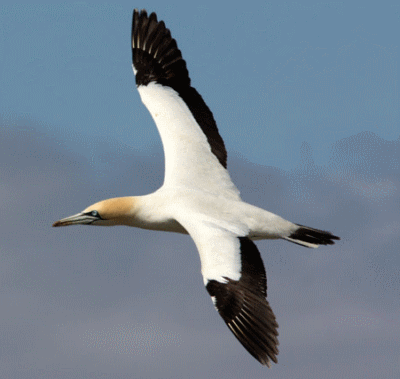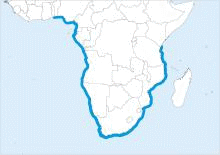 Cape Gannet Cape GannetMorus
capensis
Description
Cape gannets are easily
identified by their large size and black and
white plumage, which is noticeably silky. In
flight the black tail, primaries and secondaries,
and dark bill provide a dramatic contrast to the
snow-white body. At closer range the distinctive
golden crown and nape, which gradually become
white on the neck, are equally noticeable.
 Distribution and Habitat Distribution and Habitat
Cape gannets are found in the
waters off the Western Sahara, around Cape
Agulhas to the Gulf of Zanzibar, and occasionally
to Kenya. They are typically found within about
160 miles from the coast, but have occasionally
been recorded on oceanic waters. They breed
primarily on six offshore islands -- Mercury,
Ichaboe and Possession off the Namibian coast;
Bird and Malgas off the west coast; and Bird
Island off the east coast of South Africa.
Feeding Habits
Cape gannets feed on shoaling
fish such as sardines and pilchards. When
actively hunting, Cape gannets fly at a height of
3 to 10 feet, depending on the conditions of the
sea, with heads tilted downwards, scanning the
waters below. When a fish is spotted, they come
to a halt above the intended prey, and then
plunge into a headlong dive. A split second
before entering the water, they stretch their
wings backwards and dive in like an arrowhead.
The fish is usually swallowed before the gannet
re-surfaces.
Reproduction
The breeding season begins in
August or September. While the males busy
themselves by establishing a nesting territory,
which is typically just big enough to accommodate
the nest and the breeding pair, prospecting
females wander on the outskirts of the breeding
colony waiting for the males' advances. The
courtship ritual is fairly intricate, with the
male trying to impress the female with calling,
head shaking and bowing. Once the pair-bond has
been consolidated, the partners cooperate in nest
construction and guarding of the territory. The
nest itself is made primarily out of guano, to
which feathers, bones and other debris are added.
Eggs are laid from mid-October
to mid-December. The typical clutch is a single
bluish egg, with pairs being extremely rare. The
egg is incubated by both parents for 42 to 46
days. Gannets use their foot webs to incubate the
egg.
The hatchling is black, naked
and blind, but within three weeks its body mass
is one third that of an adult. At eight weeks the
chick outweighs the adult, and will remain
"oversized" until it fledges as 95 to
105 days. The chick is fed by both parents. Feeding
takes place in a mouth-to-mouth fashion: the
chick inserts its beak deep into the adult's gape
where the fish is regurgitated directly into the
chick's throat. Once fledged the chick is
expected to feed itself.
Scientific
Classification
phylum Chordata
subphylum Vertebrata
class Aves
order Pelecaniformes
family Sulidae
genus & species Morus capensis
Questions or comments about
this page?
|



